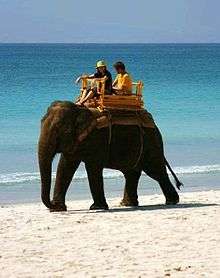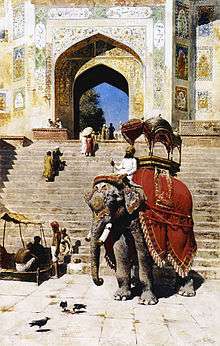Captive elephants
Elephants in captivity are elephants kept in a confining area, such as a zoo, circus, or camp, where they are fed, cared for, and mostly under veterinarian supervision, by humans and usually exhibited for entertainment or educational purposes.

In the past most elephants were captured from the wild, since this was legal and rather easy. [1]Between 1880 and 1980, a low rate of captive births meant that they breed poorly in captivity,[2] while in USA, from 1962 until 1994, 85 births were recorded, with a birth almost every second year. In 1994 about 50 of these were still living. Today, Zoos in general have a sustainable captive bred population, both in North America,[3] and Europe,[4] as well as the captive population in Thailand, where since 2008 more elephants were born, than dying, therefore balance out captive mortality.[5] Selective breeding of elephants is impractical due to their long reproductive cycle, so there are no need for domesticated breeds. There are less than 400 elephants in USA today, and totally, about 2 000 elephants has been kept in US Zoos throughout history, [6] while at least one third of the Asian species are in captivity, with at least 4 000 captive elephants only in India.[7] For comparison, the International Union for Conservation of Nature (IUCN) estimates the total population of Asian elephants in the wild to be 40,000 to 50,000,[8] and that of African elephants in the wild to be 400,000 to 600,000.[9] With less than 5 000 elephants being imported to Europe and North America since medieval times, this had less impact on the global population, compared to when a drought between 1971 and 1974 reduced only the Tsavo population with over 7 000 elephants starving to death, during three years.
History

Tame elephants have been recorded since the Indus Valley civilization around 2,000 BCE. With mahouts, they have been used as working animals in forestry, as war elephants (by commanders such as Hannibal), for cultural and ceremonial use (such as temple elephants), as a method of execution, for public displays such as circus elephants, in elephant polo and in zoological gardens.
The expression white elephant derives from a white elephant being considered sacred and therefore disqualified from useful work, yet posing a large ownership cost.[10] The origin of the expression is from the story that the kings of Siam gave white elephants as a gift to courtiers they disliked, in order to ruin the recipient by the great expense incurred in maintaining the animal.[11]
Behaviour and training


Elephants have the largest brains of all land animals, and ever since the time of Ancient Greek philosopher Aristotle,[12] have been renowned for their cognitive skills, with behavioural patterns shared with humans. Pliny the Elder described the animal as being closest to a human in sensibilities.[13] They also have a longer lifespan than most livestock. Elephants exhibit a wide variety of behaviors, including those associated with grief, learning, allomothering, mimicry, play, altruism, use of tools, compassion, cooperation, self-awareness, memory, and language. The adult male elephant annually goes through a musth period, making him dangerously aggressive.
Hand-rearing
Successful hand-rearing of orphaned calves depends critically on the milk formula used. Human infant formula is commonly used, but requires to be supplemented with bovine colostrum (commercially available in substitute form), and lactobacillus to protect the gastrointestinal tract. To provide additional fat, desiccated coconut and butterfat are added, with vitamin and mineral supplements, in particular vitamin E, vitamin B, and calcium. Rice water strained from cooked rice and glutinous rice broth are useful and are added to the formula to combat diarrhea. Rice cereal, milled whole barley or oatmeal, desiccated coconut, and other ground solid foods are added to the milk of older calves to ease the transition to solid foods.[14]
Professor Niels Bolwig at Ibadan University, Nigeria in 1963 successfully reared an orphaned infant elephant from a few days old by developing his own rich milk formula consisting of cows' milk and butter fat. This is believed to be the first successful rearing. Until then most rearing attempts had been unsuccessful due to diet intolerance.
Welfare concerns
Animal welfare researchers have raised concern about the physical and mental health of elephants in captivity at zoos in the UK and the US.[15]
Disease transmission
According to a report published by the Center for Disease Control, in North America, approximately 2% of African, and 12% of Asian captive elephants are thought to be infected with tuberculosis.[16]
In 2012, two elephants in Tete d’Or Zoo, Lyon (France), were diagnosed with tuberculosis. Due to the threat of transmitting tuberculosis to other animals or visitors to the zoo, their euthanasia was initially ordered by city authorities but a court later overturned this decision.[17]
At an elephant sanctuary in Tennessee, a quarantined 54-year-old African elephant being treated for tuberculosis was considered to be the source of latent (inactive) tuberculosis infections in eight workers.[16][18]
See also
- An Apology to Elephants (2013 documentary film)
- Khedda
- Thai Elephant Orchestra
References
- "Elephants in Captivity". ElephantVoices. Retrieved 10 April 2015.
- "Elephants, Smithsonian National Zoo". Smithsonian National Zoo and Conservation Biology Institute. Retrieved 24 February 2018.
- Koehl, D. "Elephant captive breeding in Northamerica". Elephant Encyclopedia. Retrieved 17 June 2020.
- Koehl, D. "Elephant captive breeding in Europe". Elephant Encyclopedia. Retrieved 17 June 2020.
- Koehl, D. "Elephant captive breeding in Thailand". Elephant Encyclopedia. Retrieved 17 June 2020.
- Koehl, D. "There is presently 398 (83,313) living elephants in locations in united states". Elephant Encyclopedia. Retrieved 17 June 2020.
- Koehl, D. "Elephant locations in India". Elephant Encyclopedia. Retrieved 17 June 2020.
- Choudhury, A.; Lahiri Choudhury, D.K.; Desai, A.; Duckworth, J.W.; Easa, P.S.; Johnsingh, A.J.T.; Fernando, P.; Hedges, S.; Gunawardena, M.; Kurt, F.; et al. (2008). "Elephas maximus". IUCN Red List of Threatened Species. 2008: e.T7140A12828813. doi:10.2305/IUCN.UK.2008.RLTS.T7140A12828813.en. Retrieved 16 January 2018.
- Thouless, C. R.; Dublin, H. T.; Blanc, Julian J.; Skinner, D. P.; Daniel, T. E.; Taylor, R. D.; Maisels, F.; Frederick, H. L.; Bouché, P.; IUCN/SSC African Elephant Specialist Group (2016), African Elephant Status Report 2016: an update from the African Elephant Database, Occasional Paper Series of the IUCN Species Survival Commission, 60
- "Royal Elephant Stable". Thai Elephant Conservation Center. Retrieved 7 September 2014.
- "White elephant". Oxford English Dictionary. Retrieved September 8, 2014.
- O'Connell, Caitlin (2007). The Elephant's Secret Sense: The Hidden Lives of the Wild Herds of Africa. New York City: Simon & Schuster. pp. 174, 184. ISBN 0-7432-8441-0.
- Erica Fudge, ed. (2004). Renaissance Beasts: Of Animals, Humans, and Other Wonderful Creatures. University of Illinois Press. pp. 172–173. ISBN 9780252091339.
- "Hand Raising and Diet Supplementation of Calves" - Colleen Kinzley and Karen Emanuelson Archived October 4, 2012, at the Wayback Machine
- Harris, M.; Sherwin, C.M. & Harris, S. (2008). "The welfare, housing and husbandry of elephants in UK zoos" (PDF). Defra. Retrieved January 18, 2014.
- Murphree, R; et al. "Elephant-to-human transmission of tuberculosis". Emerging Infectious Diseases. 17 (3): 366–371. doi:10.3201/eid1703.101668.
- Anon (2 March 2013). "Victory for Brigitte Bardot as elephants are reprieved". The Telegraph. Retrieved 2 March 2013.
- Ghianni, T. (18 February 2011). "Elephant behind TB outbreak at Tennessee sanctuary". Reuters. Retrieved 1 February 2013.